|
|
有趣的church sign。。。 XD XD (51楼)
[复制链接]
|
|
|

楼主 |
发表于 22-10-2007 12:15 PM
|
显示全部楼层
France, 1000–1400 a.d.
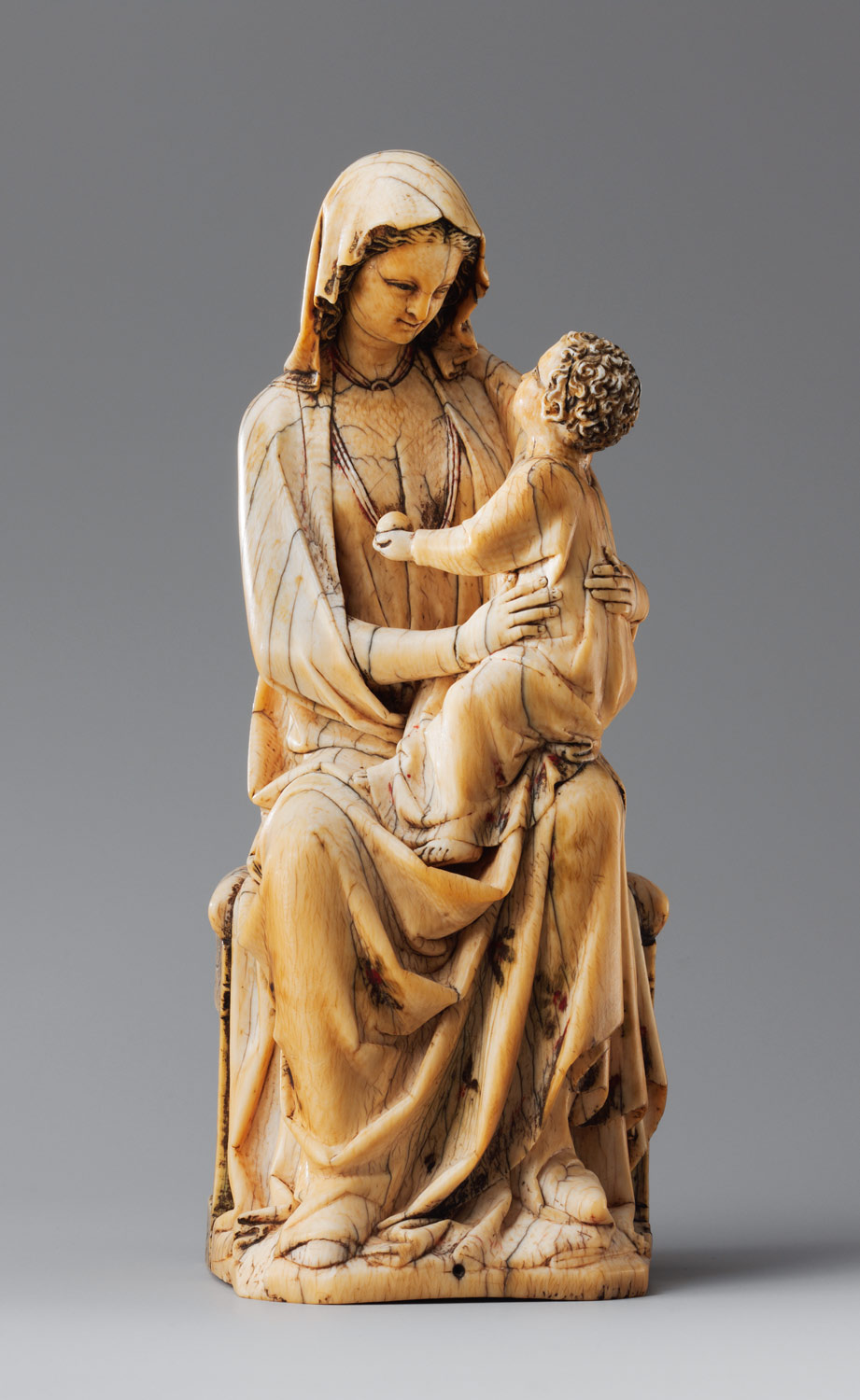
Enthroned Virgin and Child, ca. 1260–1280
French; Paris
Elephant ivory with traces of paint and gilding; H. 7 1/4 in. (18.5 cm)
Purchase, The Cloisters Collection and Michel David-Weill Gift, 1999 (1999.208)
Fewrepresentations of the Virgin and Child can match this example, regaland sensitive, produced in Paris, the principal center of ivory carvingduring the Gothic era. The face of the youthful Virgin emphasizes hertenderness toward the Christ Child. Here the focus of the work is onthe human and loving mother rather than the Queen of Heaven. Thestatuette was probably set into a small architectural tabernacle, andfunctioned as an object for private devotion.
數交涉,維爾京和兒童可以配合這個例子裡,富豪和敏感,生產在巴黎,主要中心的象牙雕刻,在哥特時代。面對青春維爾京強調,她的溫柔,對基督的孩子。在這裡工作的重點是對人類和慈母,而不是女王的天堂。該statuette大概定到一個小建築鹽湖城,並充當了一個對象,為私人奉獻。
[ 本帖最后由 daimon 于 23-10-2007 11:19 PM 编辑 ] |
|
|
|
|
|
|
|
|
|
|
|

楼主 |
发表于 22-10-2007 12:16 PM
|
显示全部楼层
France, 1000–1400 a.d.
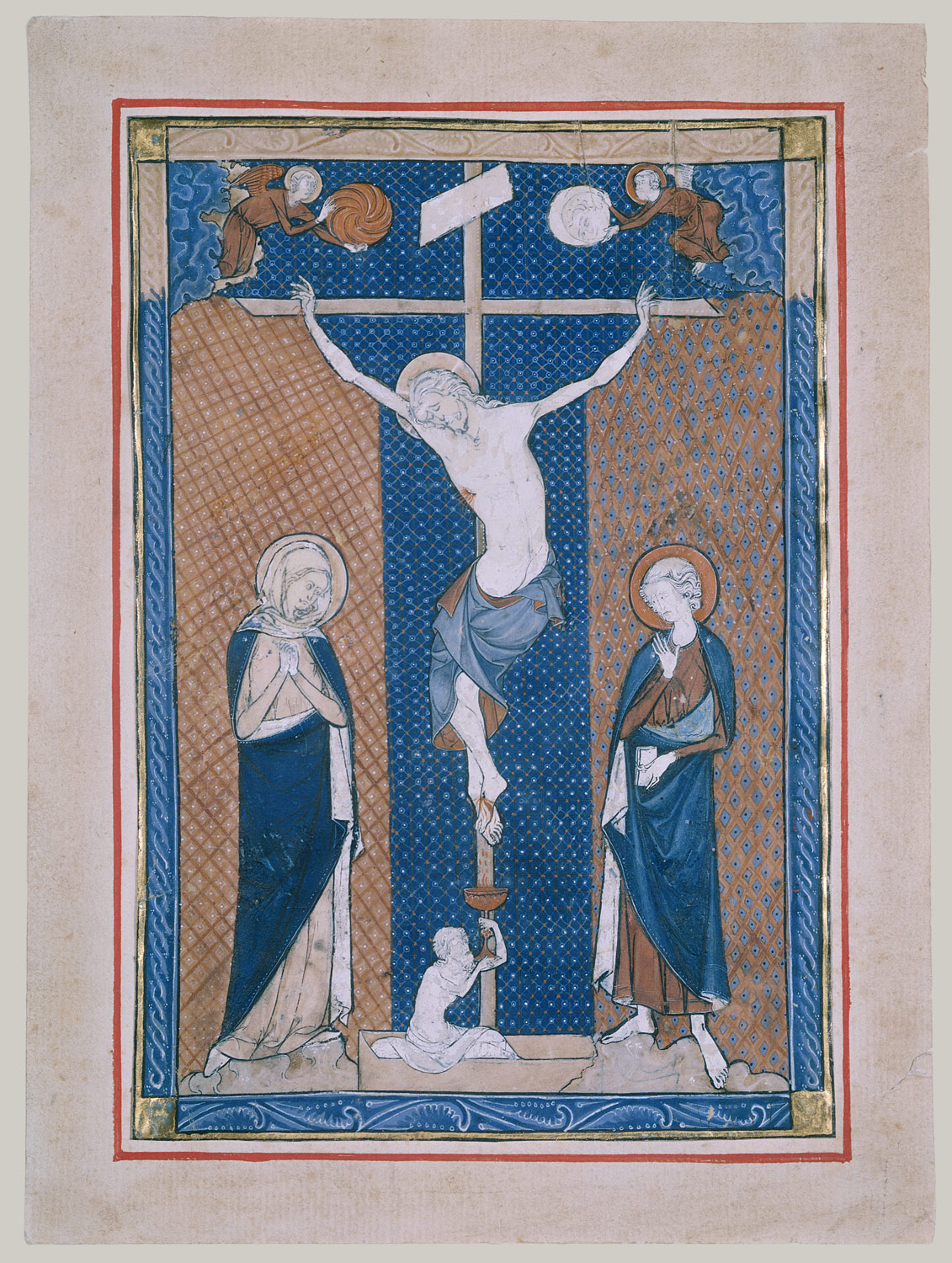
Leaf from a Missal, ca. 1270–1290
French; Made in Paris
Tempera and gold leaf on parchment; 8 3/4 x 5 7/8 in. (22.2 x 14.9 cm)
Purchase, Bequest of Thomas W. Lamont, by exchange, 1981 (1981.322)
Anexquisite example of what Dante termed "that art which, at Paris, theycall illumination," this painting on parchment was once set into amissal containing the liturgical texts for the celebration of the Mass.Here, as Jesus hangs on the cross, flanked by the Virgin Mary and SaintJohn, the diminutive figure of Adam rises from a sarcophagus at thefoot of the cross and collects the sacrificial blood that spills fromthe wound in Christ's foot in a chalice of the type used incontemporary services. Two angels bearing symbols of the sun and moonemerge from clouds at each of the upper corners. The figures aredramatically isolated against alternating panels of diapered andtessellated backgrounds.
一個精美的例子,什麼但丁被稱為"藝術,其中,在巴黎,他們呼籲光照, "這幅畫就羊皮紙曾經訂成missal載禮儀文本,以供慶祝該mass.here,正如耶穌掛於十字架兩旁是聖母瑪利亞及聖約翰,這種小型數字亞當上升,從石棺上的腳交叉,並收集了祭祀血液外溢,從傷口在基督的腳在宗徒的類型用在當代服務。兩個天使軸承象徵太陽和月亮出現的雲彩在每一項上的彎道。這些數字大大孤立打擊交替面板的中華民族和葉脈背景。
[ 本帖最后由 daimon 于 23-10-2007 11:20 PM 编辑 ] |
|
|
|
|
|
|
|
|
|
|
|

楼主 |
发表于 22-10-2007 12:19 PM
|
显示全部楼层
France, 1000–1400 a.d.

Two Grisaille Panels, 1320–1324
French; Paris, from the Chapel of Saint-Louis, north aisle, royal abbey of Saint-Denis
Pot-metal and white glass, silver stain: Each 23 1/2 x 15 1/4 in. (59.7 x 38.7 cm)
The Cloisters Collection, 1982 (1982.433.3,4)
Traditionallythought to have come from the Cathedral of Notre-Dame in Paris, thispair of grisaille panels is now attributed to the Chapel of Saint-Louisat the royal abbey of Saint-Denis. Their distinctive feature, theinclusion of the small fleurs-de-lis, which sprout, budlike, from thestems of the foliage, is unique to these panels and to four otherrelated examples—a detail that may well indicate that the glass wascreated for a royal foundation. The most likely candidate isSaint-Denis, the royal necropolis, where a nave chapel dedicated toLouis IX—who was canonized as Saint Louis in 1297—was completed by1324. The rebuilding of the abbey church began shortly after Louisascended to the throne and continued throughout most of his reign(1226–70).
傳統上被認為是來自大教堂的聖母-貴婦人在巴黎,這對grisaille面板,是目前歸於該教堂的聖louisat皇家修道院的聖但尼省。其鮮明的特點,加入小fleurs德-土地信息系統,其中苗,芽一樣,從莖的觀葉,是獨一無二的,以這些小組和四個其他相關的例子來說,一個細節很可能表明,該玻璃創造一個皇家基礎。最有可能的人選是聖但尼省,皇家史賓,凡得很教堂專門路易九人被冊封為聖路易在1297年-完成by1324。重建該修道院教堂開始後不久,路易斯以嶄寶座,並繼續進行他的大部分時期( 1226至1270年) 。
[ 本帖最后由 daimon 于 23-10-2007 11:21 PM 编辑 ] |
|
|
|
|
|
|
|
|
|
|
|

楼主 |
发表于 22-10-2007 12:21 PM
|
显示全部楼层
France, 1000–1400 a.d.
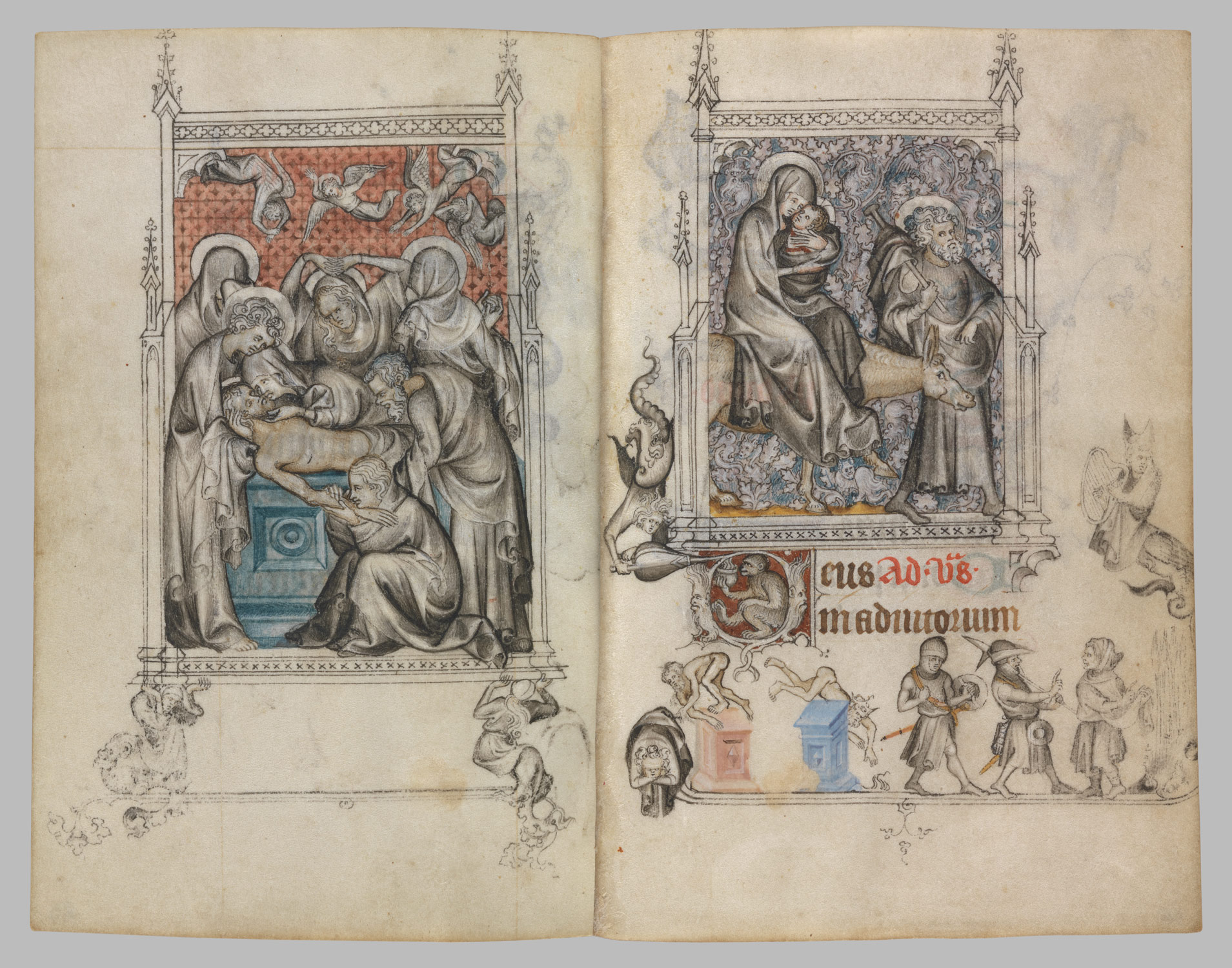


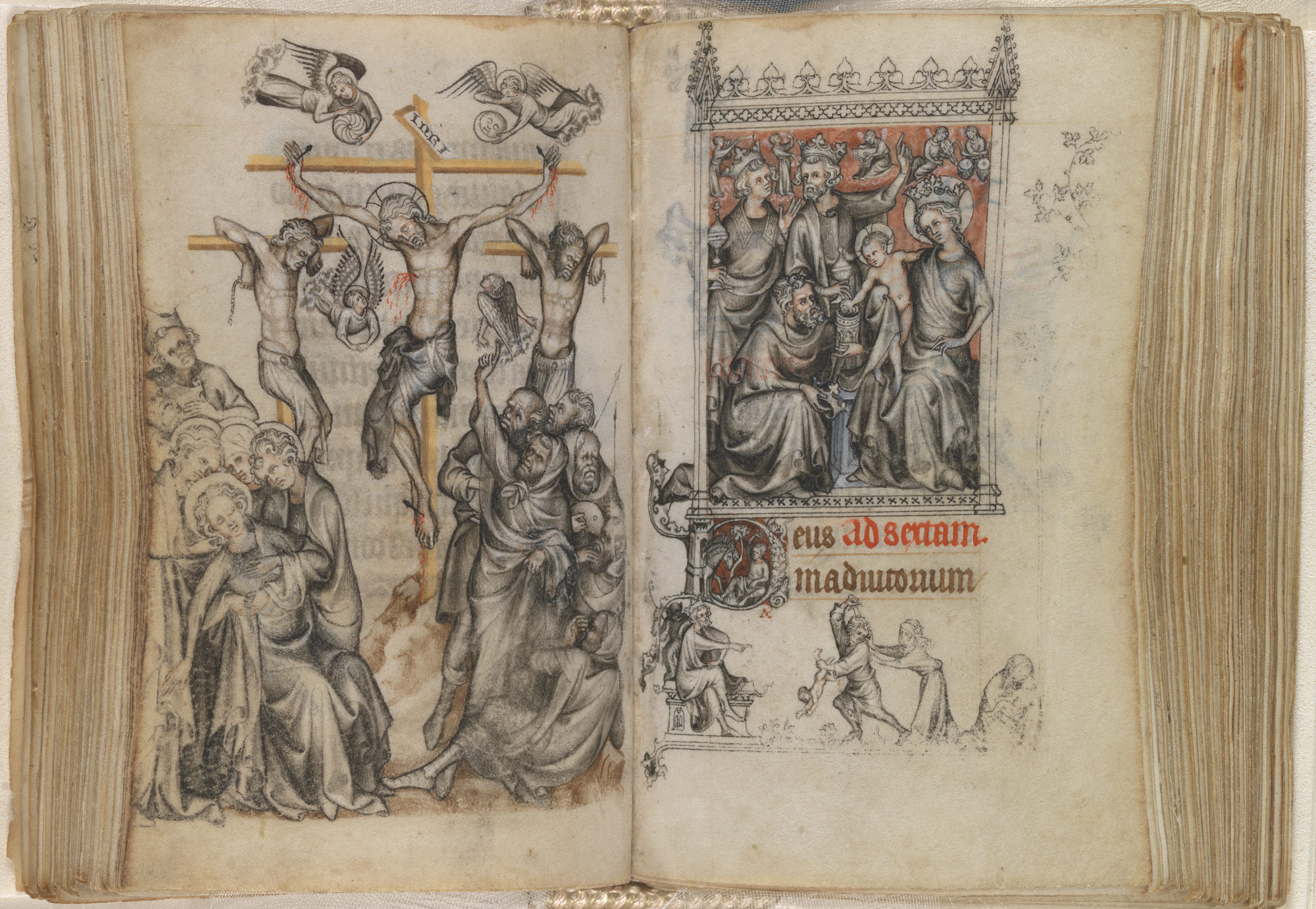
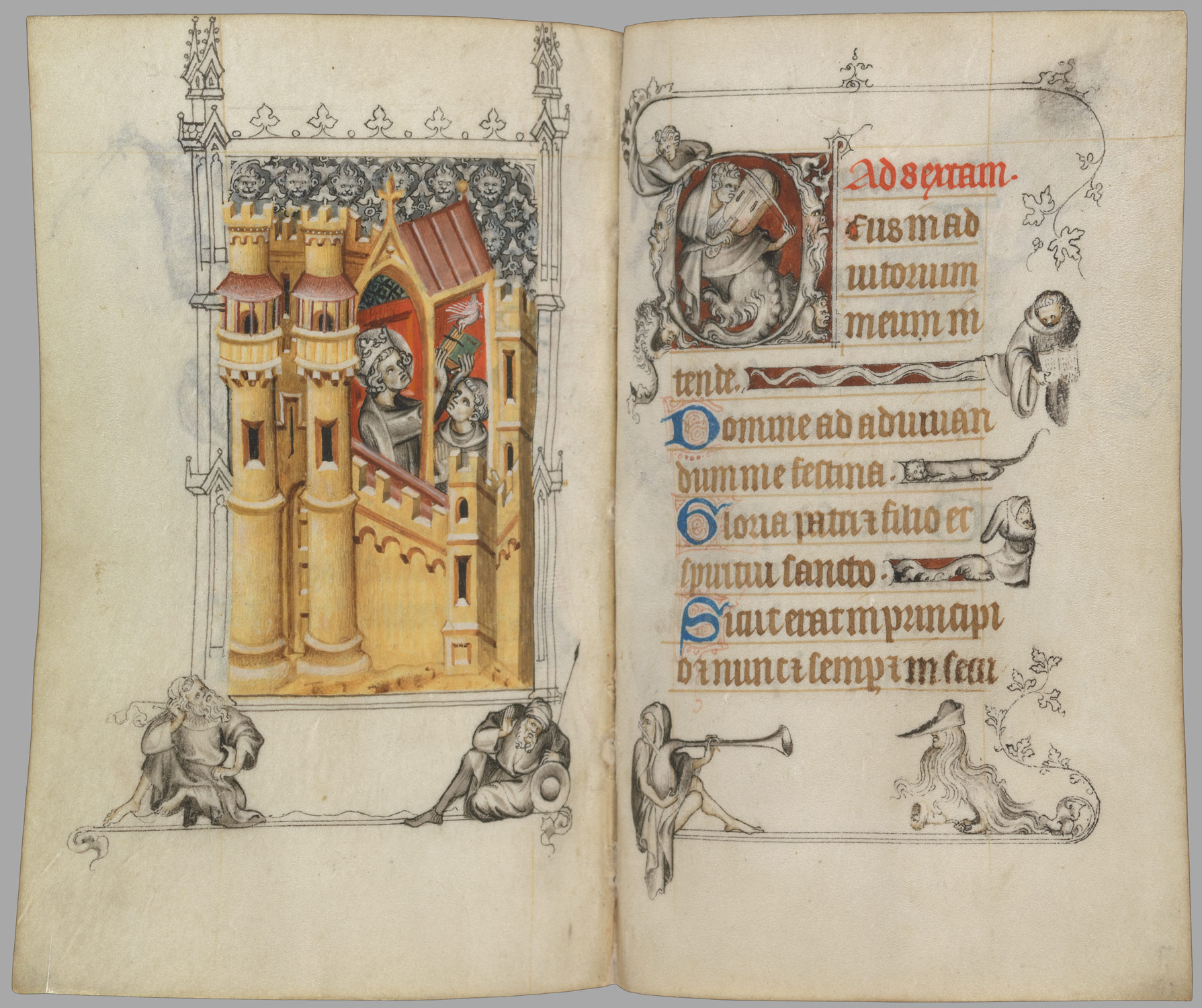
The Hours of Jeanne d'Évreux, ca. 1324–1328
Jean Pucelle (French, active in Paris, ca. 1320–34)
French; Made in Paris
Grisaille and tempera on vellum; 3 1/2 x 2 7/16 in. (8.9 x 6.2 cm)
The Cloisters Collection, 1954 (54.1.2)
The 209 folios of The Hours of Jeanne d'Évreuxinclude 25 full-page paintings with paired images from the Infancy andPassion of Christ and scenes of the life of Saint Louis. The figuresare rendered in delicate grisaille (shades of gray) that imparts anamazingly sculptural quality, and the images are accented with richreds and blues and touches of orange, yellow, pink, lilac, andturquoise. In the margins, close to 700 illustrations depict thebishops, beggars, street dancers, maidens, and musicians that peopledthe streets of medieval Paris, as well as apes, rabbits, dogs, andcreatures of sheer fantasy. All are brought to life by the keenobservation, accomplished draftsmanship, and consummate imagination ofthe artist.
This lavishly illustrated prayer book (Book of Hours) was createdbetween 1324 and 1328 for Jeanne d'Évreux, queen of France, by thecelebrated Parisian illuminator Jean Pucelle (active ca. 1320–34) andwas intended for use by the queen during private prayer throughout thecourse of the day. Upon her death in 1371, Jeanne d'Évreux left theprayer book to King Charles V. At his death, the book entered thecollection of another much lauded bibliophile, his brother Jean, Dukeof Berry.
209個袖珍的時間,珍妮德évreuxinclude25日以整版篇幅繪畫與圖像配對,從嬰兒期和激情的基督和場景的生命聖路易斯。該數字已變得微妙grisaille (陰涼灰色)imparts驚人的雕塑的質量,以及圖像口音,具備豐富的紅方和藍方,涉及到的橙色,黃色,粉色,丁香,和綠松石。在此其間,近700插圖描繪主教,乞丐,街頭舞者,少女,和音樂家說,peopled街頭中世紀巴黎,以及類人猿,兔,狗,和海洋生物的,純屬天方夜譚。所有的人繩之以法,以生命所熱衷的觀察,完成了石印,並完善想像力的藝術家。
這顯示了極高的祈禱書(該書小時計) ,是創造之間第1324和1328年為珍妮德évreux,女王,法國,由巴黎慶祝燈讓pucelle (有源鈣。 1320年至1334年),並打算用於由女王在私人祈禱的整個過程中的一天。當她死在1371年,珍妮德évreux離開祈禱這本書給國王查爾斯五,在他死後,這本書進入收集另一個備受稱讚bibliophile ,他的弟弟米夏埃爾dukeof漿果。
[ 本帖最后由 daimon 于 23-10-2007 11:22 PM 编辑 ] |
|
|
|
|
|
|
|
|
|
|
|
 发表于 22-10-2007 10:32 PM
|
显示全部楼层
发表于 22-10-2007 10:32 PM
|
显示全部楼层
请使用中文来发贴,不然会关闭此主题。
虽然主题很好,但是还是需要遵守版规。
限定三天之内处理,谢谢给与合作。 |
|
|
|
|
|
|
|
|
|
|
|
 发表于 22-10-2007 11:51 PM
|
显示全部楼层
发表于 22-10-2007 11:51 PM
|
显示全部楼层
|
|
|
|
|
|
|
|
|
|
|

楼主 |
发表于 23-10-2007 09:10 PM
|
显示全部楼层
Italian Peninsula
现在的Italy(包括 西西里的伊特鲁里亚岛&撒丁岛)&法国的科西嘉
Encompasses present-day Italy (including the Tyrrhenian islands of Sicily and Sardinia) and Corsica
#28 - ?? 楼
[ 本帖最后由 daimon 于 24-10-2007 12:43 AM 编辑 ] |
|
|
|
|
|
|
|
|
|
|
|

楼主 |
发表于 24-10-2007 12:01 AM
|
显示全部楼层

Italian Peninsula, 500–1000 a.d.
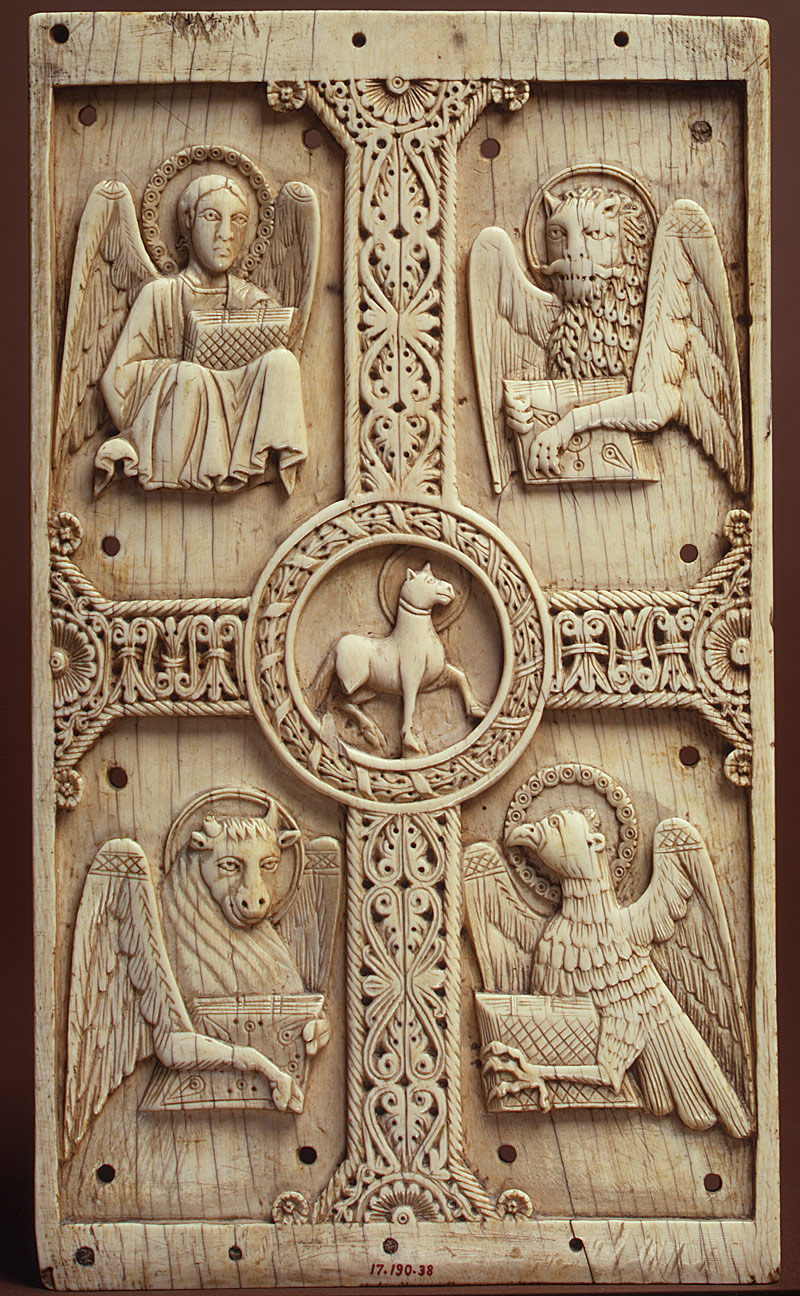

Plaque with Agnus Dei and Four Evangelists, probably 9th century
German or North Italian
Ivory; 9 1/4 x 5 3/8 in. (23.5 x 13.7 cm)
Gift of J. Pierpont Morgan, 1917 (17.190.38)
Thewriters of the four Gospels, which relate the story of Christ's life,were often symbolized by animals. Winged creaturees stood for Matthew,a lion for Mark, an ox for Luke, and an eagle for John. These symbolswere based upon the vision of Saint John in the Book of Revelation(4:6–7). On this ivory plaque, the animal symbols, holding theirGospels, are arranged around the cross. At the center appears the Lambof God, a symbol of Christ. Originally, this plaque would havedecorated the cover of an Evangiliary, a manuscript containing all fourGospels.
作者四個福音書,其中涉及的故事基督的生命,往往被其象徵動物。翅creaturees主張馬修,獅子為標誌,牛為盧克,和一個老鷹球,為約翰。這些符號都是基於遠見的聖約翰在書中的啟示( 4:6-7 )。關於這個象牙牌匾,動物符號,持有其福音,是安排圍繞兩岸關係。在該中心似乎羔羊的上帝,象徵基督。本來,這牌匾將有裝飾的封面上的一個evangiliary ,手稿包含了所有4個福音。
[ 本帖最后由 daimon 于 24-10-2007 12:43 AM 编辑 ] |
|
|
|
|
|
|
|
|
|
|
|

楼主 |
发表于 24-10-2007 12:04 AM
|
显示全部楼层
Italian Peninsula, 500–1000 a.d.
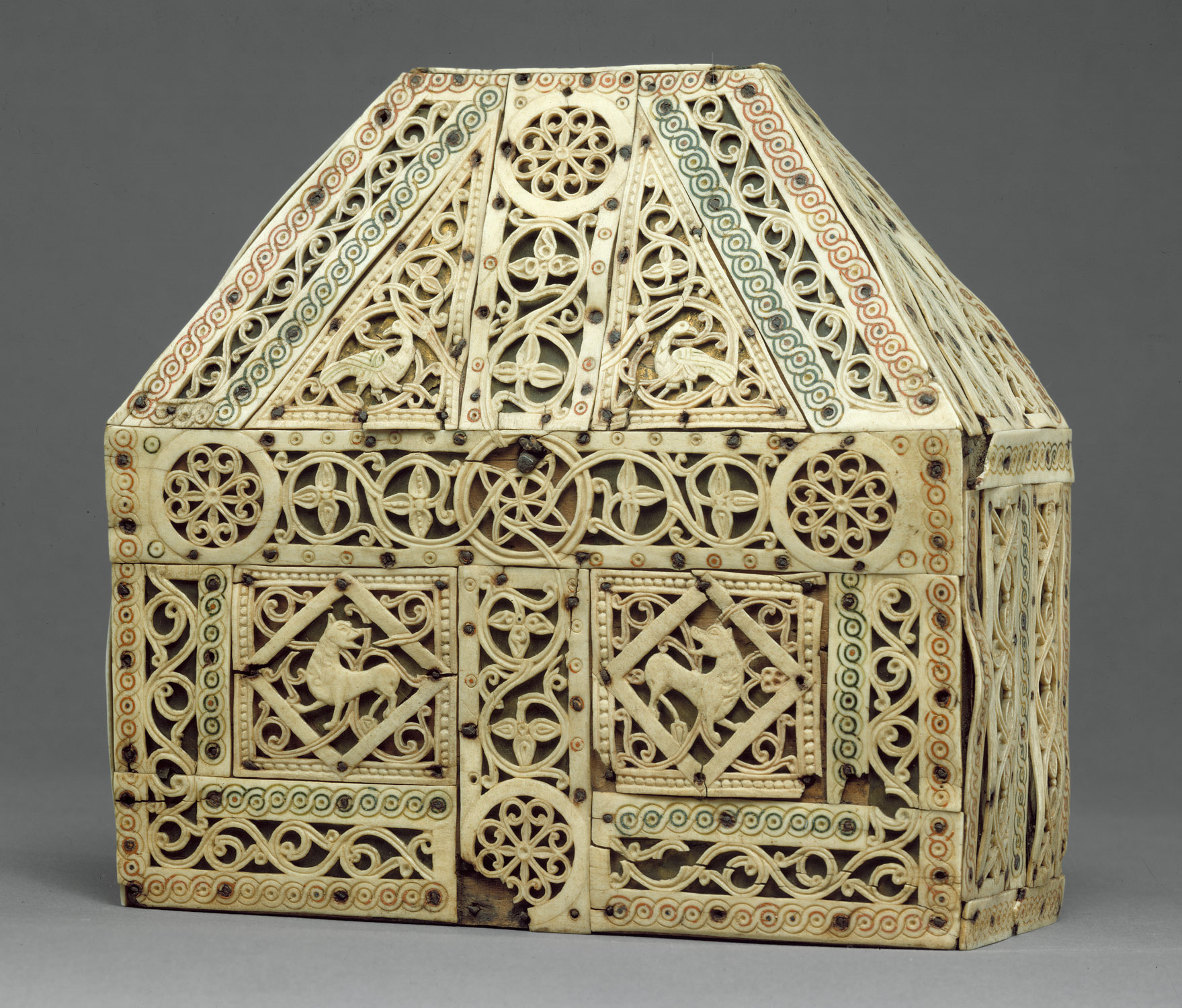
Bursa Reliquary, early 900s
North Italian
Bone, copper-gilt, wood; 7 3/4 x 7 5/16 x 3 1/4 in. (19.7 x 18.6 x 8.3 cm)
The Cloisters Collection, 1953 (53.19.2)
Bursa, or purse-shaped,reliquaries are one of the oldest types of reliquary, with numeroussurviving examples from the seventh century onward. This one, datingfrom the tenth century, displays a masterful treatment of ivory whereinthe surface is modeled by incision and relief carving while thebackground is pierced through (ajouré). In the Middle Ages, itwas common for ivory-covered reliquaries to display scenes of the lifeof the saint, whose remains were held within the container, but in thisexample, the ivory displays more purely decorative imagery.
布爾薩,或者錢包形,reliquaries是一個最古老類型的義莊的,有許多倖存的例子,從公元7世紀起。這其中,可以追溯到10世紀,顯示一個熟練的治療象牙,其中表面是仿照由切口和救濟雕刻,而背景是射穿( ajouré )。在中世紀,它是常見的象牙蓋reliquaries展示的場面,生命的守護神,其遺體舉行集裝箱,但在這個例子中,象牙顯示器更純粹的裝飾性意象。 |
|
|
|
|
|
|
|
|
|
|
|

楼主 |
发表于 24-10-2007 12:07 AM
|
显示全部楼层
Italian Peninsula, 500–1000 a.d.
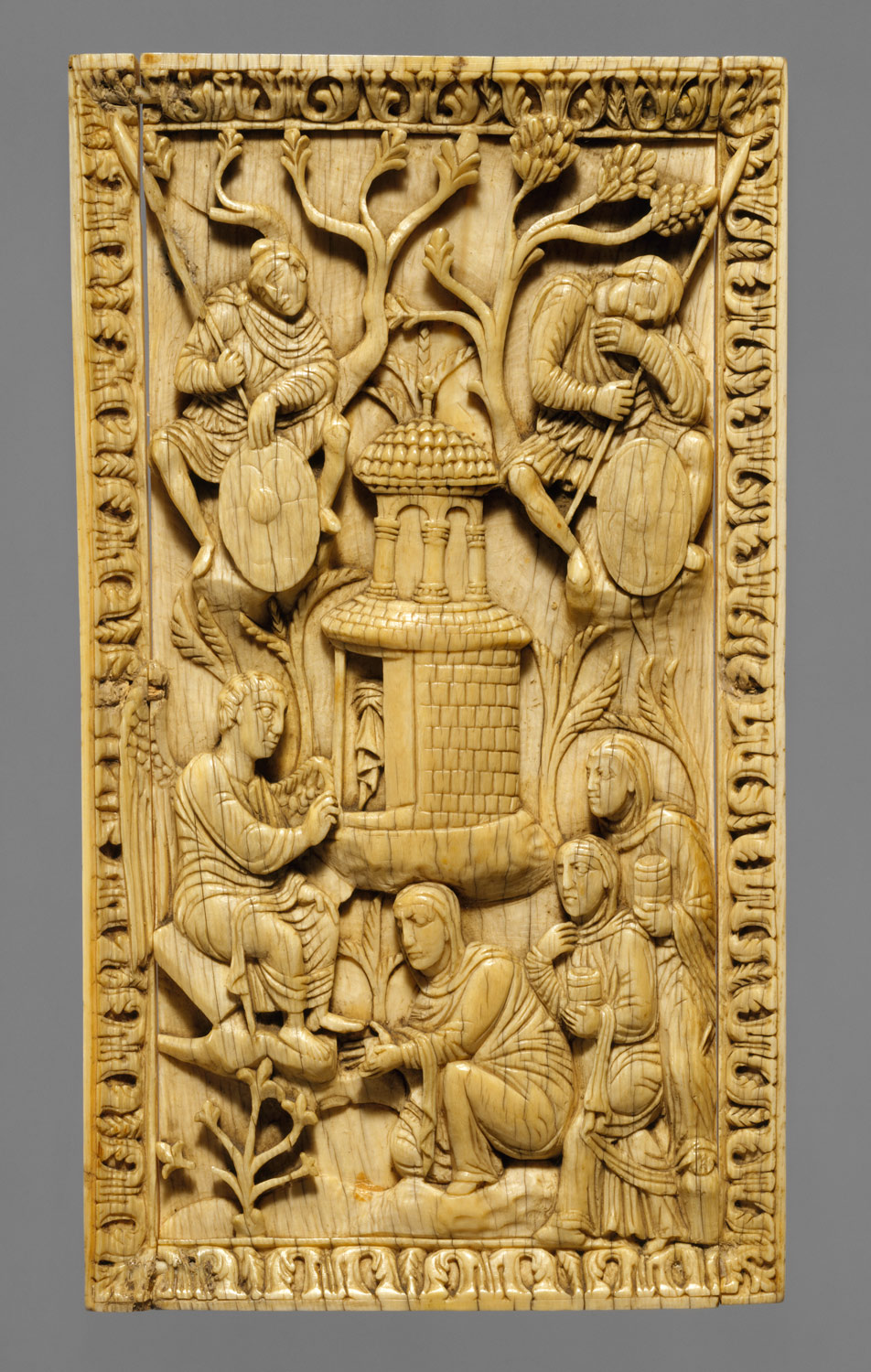
Three Holy Women at the Holy Sepulcher, early 10th century; Ottonian
Possibly modern Milan, Northern Italy
Elephant ivory; 7 1/2 x 4 1/4 in. (19 x 10.8 cm)
Purchase, The Cloisters Collection and Lila Acheson Wallace Gift, 1993 (1993.19)
Thisivory plaque representing the Easter miracle of Christ's resurrectionfrom the dead probably once served as part of a decorative cover for aliturgical manuscript. It shows the visit of the three women to theHoly Sepulcher, the burial place of Christ, where they discover anangel guarding the empty tomb. The soldiers guarding the tomb are soundasleep. Christ's absence is emphasized here as his abandoned shroudhovers in the doorway of the towered mausoleum at center. Scenes of thewomen at the empty tomb are featured with relative frequency on ivoriesof the ninth and early tenth centuries, an artistic development thatseems to coincide with an increased emphasis on the events at the tombseen in the Easter liturgy of this period.
這個象牙牌匾代表復活節的奇蹟基督的復活從死者可能是曾經擔任過的一個組成部分裝飾罩一個禮儀手稿。這顯示出訪問的三名女子,以神聖的墳墓,埋葬地點基督,在那裡發現了一個天使守護著空墓。戰士們守護著墓室正酣睡。基督的缺席是在此間強調,作為他放棄了籠罩徘徊在大門口的連雲陵園中鋒。場面的婦女在空墓,具有相對頻率對象牙的第九屆和第十屆早幾百年,是一個藝術的發展似乎是為了配合更加注重對事件,在墓出現在復活節禮儀這一時期。 |
|
|
|
|
|
|
|
|
|
|
|

楼主 |
发表于 24-10-2007 12:08 AM
|
显示全部楼层
Italian Peninsula, 500–1000 a.d.
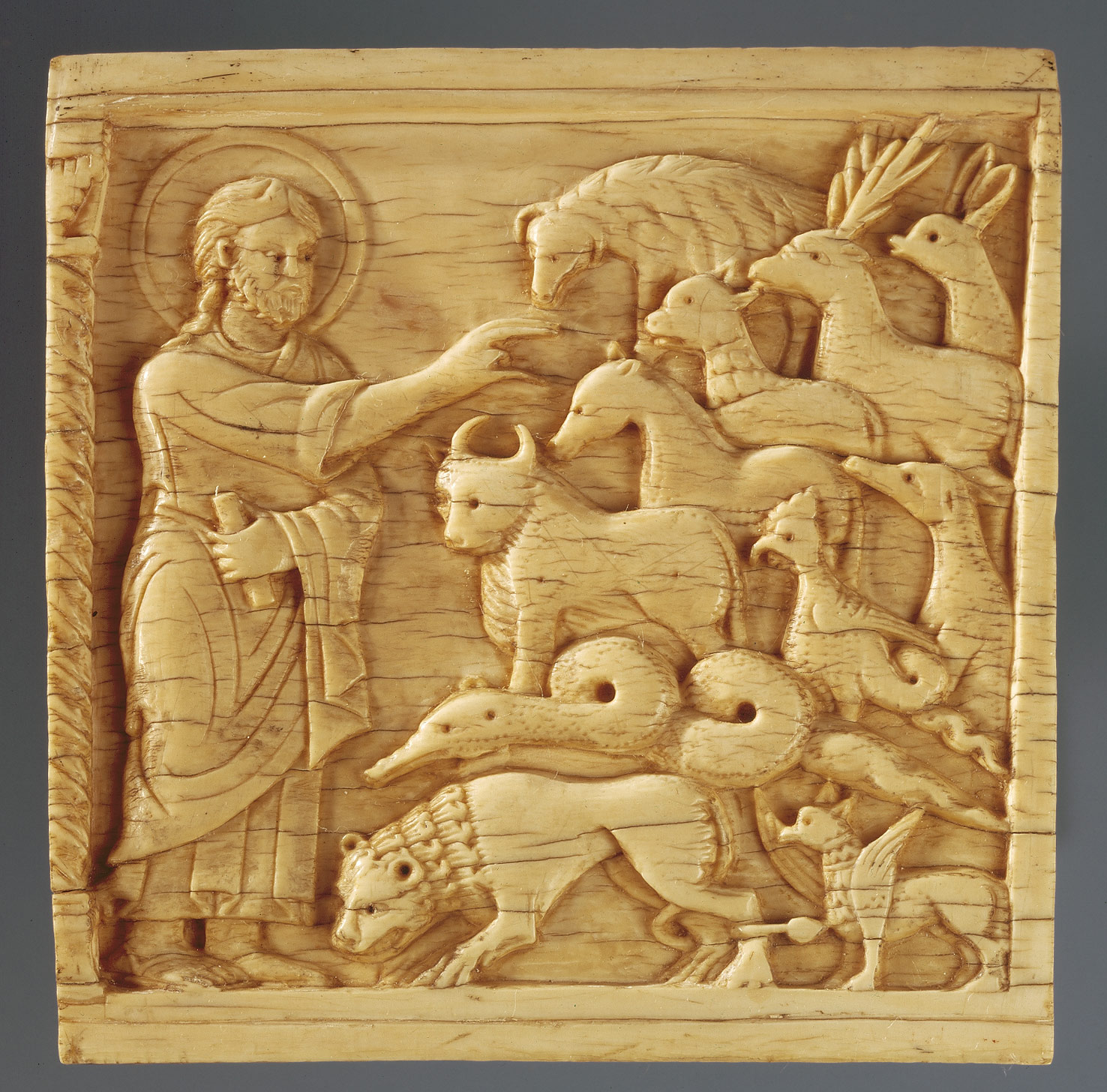
Plaque with the Creation of Animals, ca. 1084
South Italian; modern Amalfi (Campania)
Ivory; 4 1/4 x 4 1/4 in. (10.8 x 10.8 cm)
Gift of J. Pierpont Morgan, 1917 (17.190.156)
Thisivory plaque comes from a set of some fifty ivories showing scenes fromthe Bible. Forming an extensive narrative, they may have decorated alarge piece of church furnishing--perhaps the enclosure before thealtar--for the Cathedral of Salerno dedicated in 1084.
這個象牙牌匾來自一套約五十名象牙顯示場景,從聖經。形成了一個廣泛的敘述,他們也許有裝飾一大塊教會家具-也許是文前的祭壇上-為大教堂的s a lerno致力於在1 0 84份。 |
|
|
|
|
|
|
|
|
|
|
|

楼主 |
发表于 24-10-2007 12:10 AM
|
显示全部楼层
Italian Peninsula, 1000–1400 a.d.
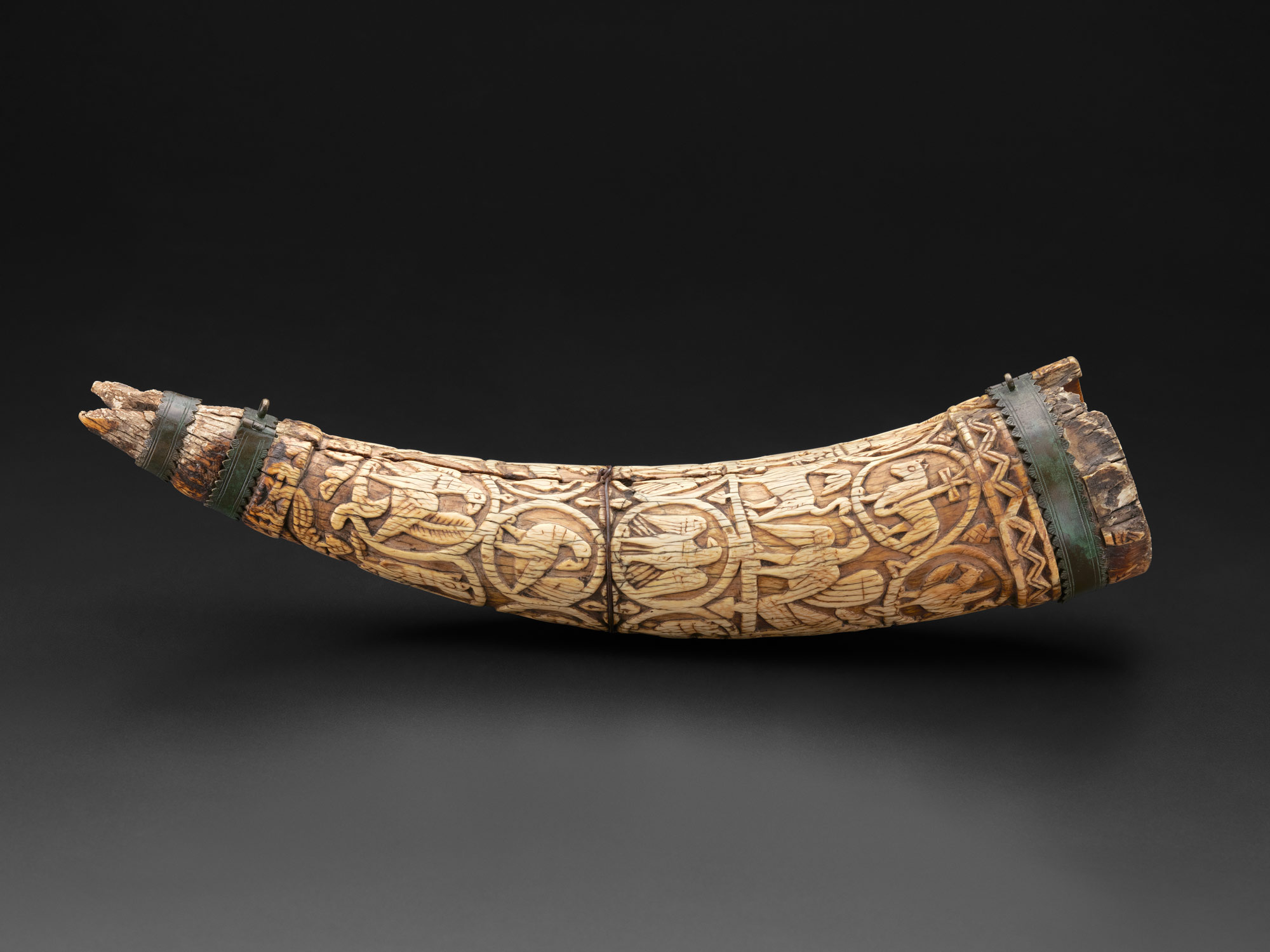
Horn, ca. 1100–1200
South Italian
Ivory; 17 x 3 1/2 in. (43.2 x 8.9 cm)
Gift of J. Pierpont Morgan, 1917 (17.190.218)
Large decorated elephant tusks were used for both religious and secular purposes. They could be employed as drinking vessels, as horns to announce the hunt, or as symbols of feudal rights. Many were given to churches, and some served as reliquary containers. This example shows Christ as the Lamb of God.
大型裝飾大象象牙則用於宗教和世俗的目的。他們可以被聘用為飲用水容器,由於犀角公佈捕獵,或作為象徵封建權利。許多人給教會,有的擔任義莊容器。這個例子說明,以基督為羔羊的上帝。
|
|
|
|
|
|
|
|
|
|
|
|

楼主 |
发表于 24-10-2007 12:15 AM
|
显示全部楼层
Italian Peninsula, 1000–1400 a.d.
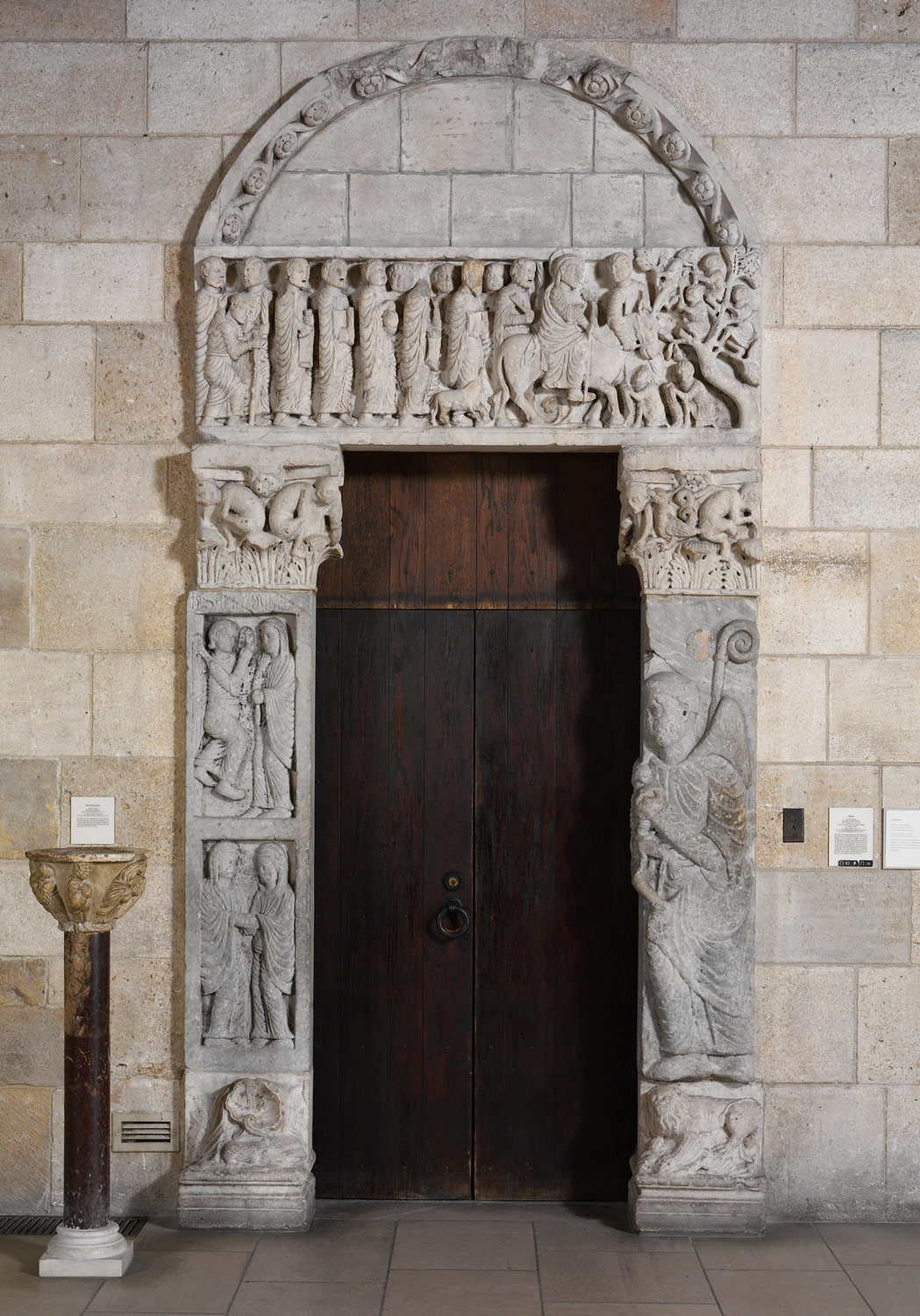
Portal from the Church of San Leonardo al Frigido, ca. 1170–1180
Italian; Made in Tuscany
White Carrara marble, grayish marble; 13 ft. 2 in. x 76 in. (401.3 x 193 cm)
The Cloisters Collection, 1962 (62.189)
During the twelfth century, the exterior walls of churches and cathedrals in northern and central Italy were decorated with scenes from the Bible and the lives of local saints. Dedicated to Saint Leonard, the patron saint of prisoners, this portal served as the main entrance of the small Church of San Leonardo al Frigido in Tuscany. An antique sarcophagus was reused for the supporting jambs on the sides of the door; it was carved to show scenes of the Annunciation and the Visitation on the left and an image of Saint Leonard holding an emblematic prisoner on the right. The Entry into Jerusalem on the lintel is modeled after an Early Christian tomb relief, reflecting the revival of interest in late antique and early Christian art that occurred in Italy during the twelfth century. The doorway is ascribed to the workshop of Master Biduino, who worked in the Pisa-Lucca area.
在12世紀,外牆的教堂和教堂,在北部和中部意大利的裝飾畫面,從聖經及生命當地聖人。致力於聖徒倫納德,守護神的囚犯,這門作為正門的小教堂的聖萊昂納多基地frigido在托斯卡納。古董石棺被重新用於配套門窗對兩岸的大門;這是刻表現出場面的annunciation並探望在左邊和形象聖徒倫納德舉行一次象徵性的囚犯在右邊。進入耶路撒冷就門楣,是仿照早期基督教墓救濟,反映復甦的興趣,已故的古董和早期基督教藝術的,就是發生在意大利,在12世紀。門口是歸因於該車間的主人biduino曾在比薩-盧卡地區。 |
|
|
|
|
|
|
|
|
|
|
|

楼主 |
发表于 24-10-2007 12:17 AM
|
显示全部楼层
Italian Peninsula, 1000–1400 a.d.
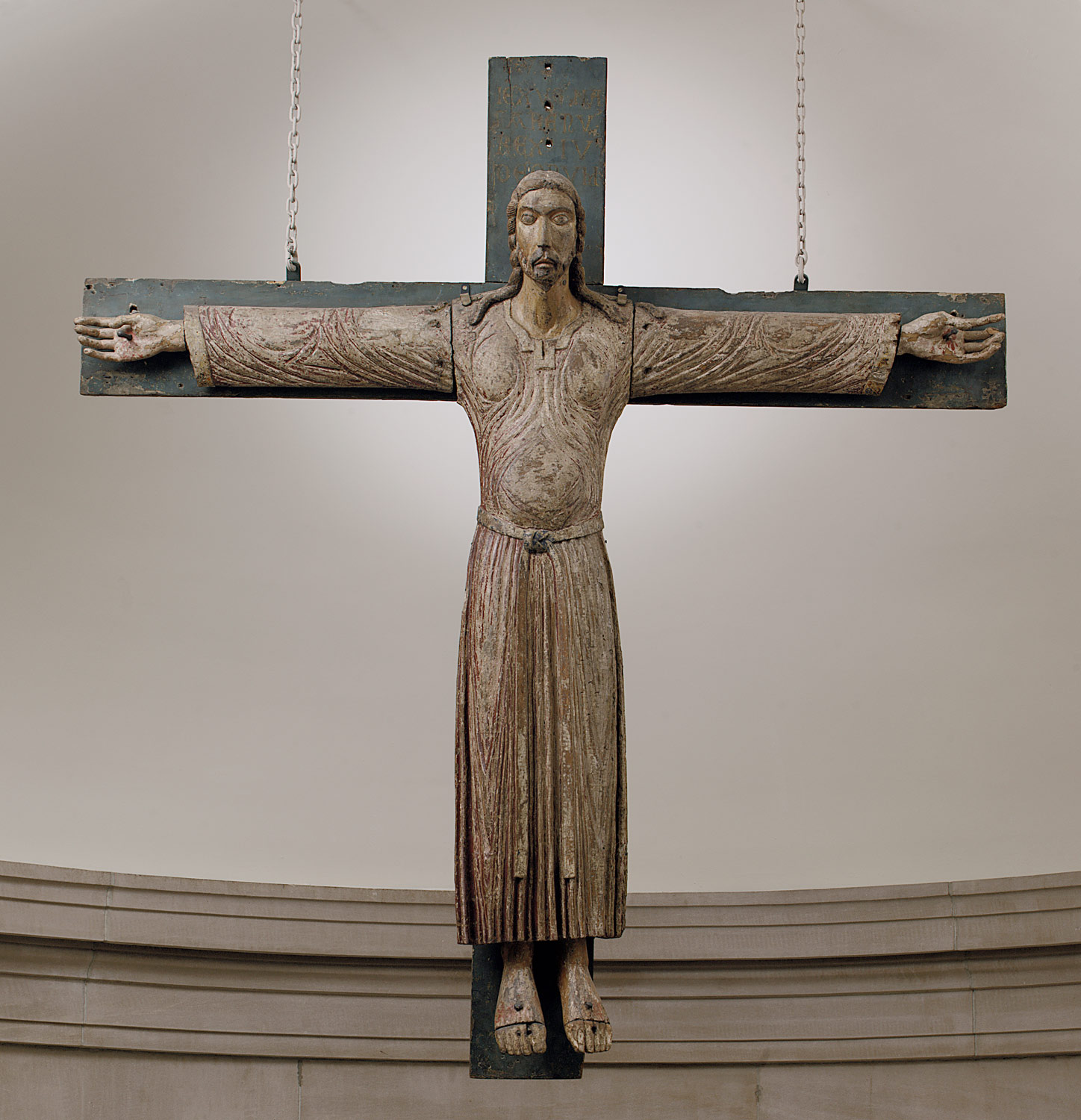
Crucifix, 1180–1230
Said to be from a monastery near Treviso, northern Italy
Wood with traces of paint
Fletcher Fund, 1947 (47.100.54)
Rather than emphasizing his pain and suffering on the cross, this image presents Christ in glory, alive, eyes wide open. He wears a full-length robe connoting his kingly and priestly rank. This type of crucifix is known as the Volto Santo (Holy Face). It is a copy of a sculpture in Lucca, Italy. The Lucca crucifix was likely made in the 700s, but medieval legend held that it was made by Nicodemus, a disciple of Jesus who witnessed the Crucifixion.
不強調他的痛苦和苦難的十字架,這種形象介紹基督教的榮耀,在世時,瞪大眼睛。戴完整長度的長袍含意他王道和教義號牌。這種類型的十字架,也是眾所周知的所謂volto聖多明各(聖地面) 。這是一個複製一個雕塑,在意大利盧卡。該盧卡十字架可能在700s,但中世紀傳說認為,它是由種族,弟子耶穌的人,見證了十字架上。
|
|
|
|
|
|
|
|
|
|
|
|

楼主 |
发表于 24-10-2007 12:19 AM
|
显示全部楼层
Italian Peninsula, 1000–1400 a.d.
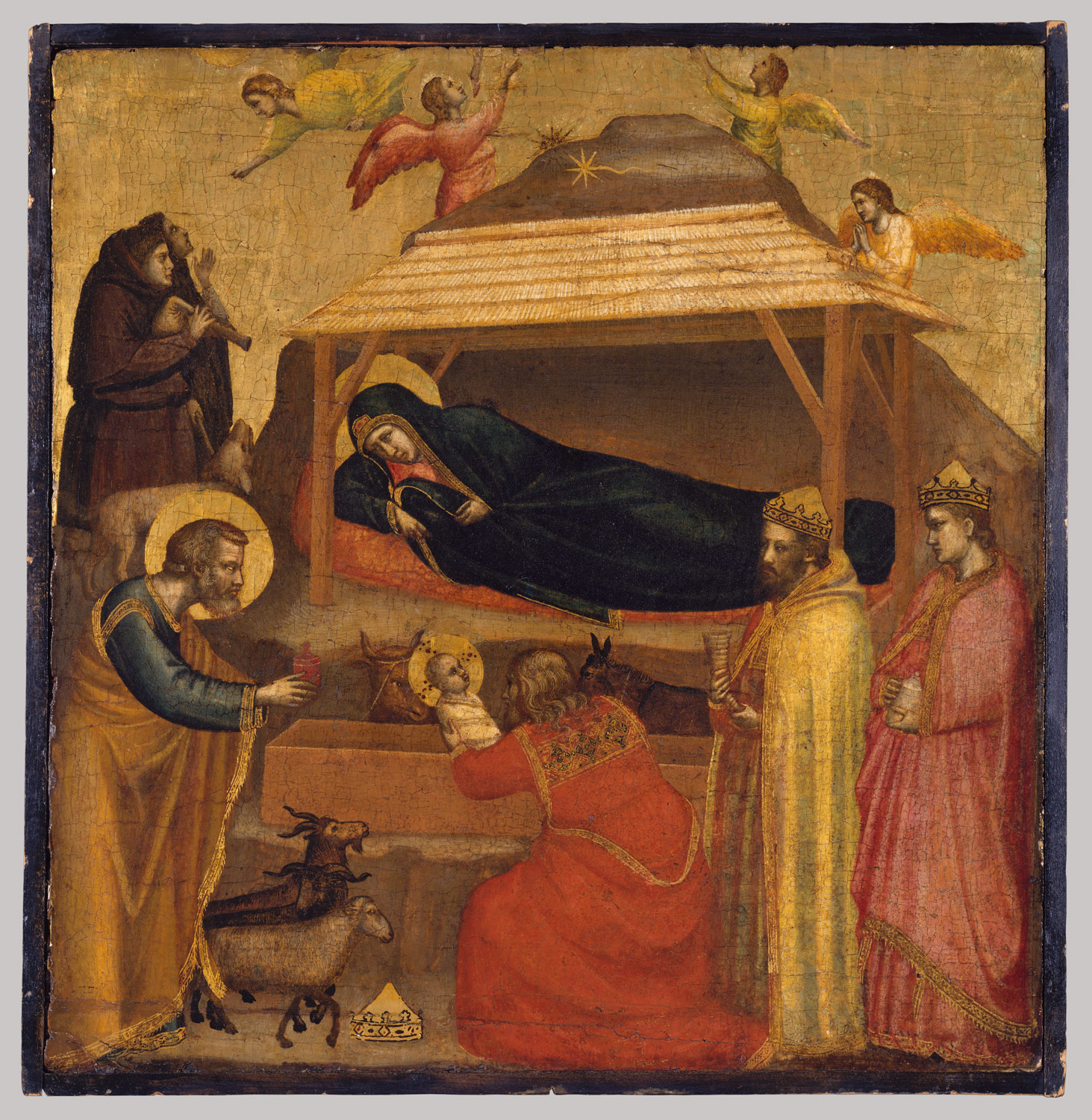
The Epiphany, possibly ca. 1320
Giotto di Bondone (Italian, Florentine, 1266/76–1337)
Tempera on wood, gold ground; 17 3/4 x 17 1/4 in. (45.1 x 43.8 cm)
John Stewart Kennedy Fund, 1911 (11.126.1)
Giotto was the most famous artist of his day, praised by Dante and considered by his successors to have revived the art of painting after centuries of decline. This panel is part of a series of scenes from the life of Christ, of which six others are known. They may come from one of the four altarpieces by Giotto recorded in the Franciscan Church of Santa Croce in Florence. The way in which the figures move freely within a carefully described space is close to that of frescoes painted by the artist in about 1320 for the same church.
giotto是最有名的藝術家,他的一天,稱讚但丁,並考慮由他的繼任者都恢復了繪畫藝術經過幾百年的下降。這個小組是一連串的場景,從生活中的基督,其中,其他6個是眾所周知的。他們可能來自一家四大altarpieces由giotto記錄在方濟各教堂的聖克羅齊在佛羅倫薩。以何種方式數字自由移動精心描述空間是接近這樣的手繪壁畫由藝術家在大約13時20為同一教會。 |
|
|
|
|
|
|
|
|
|
|
|

楼主 |
发表于 24-10-2007 12:23 AM
|
显示全部楼层
Italian Peninsula, 1000–1400 a.d.

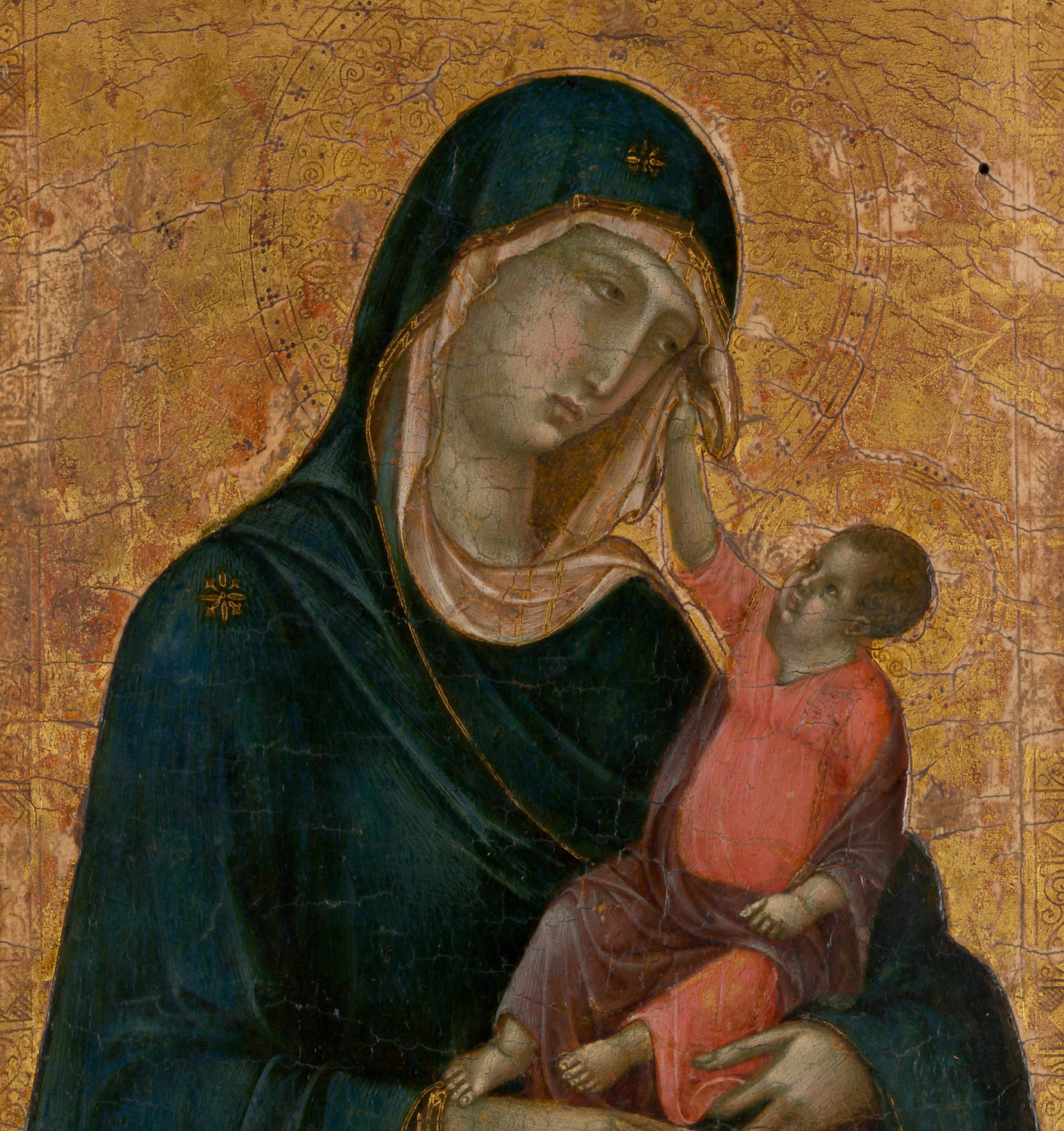

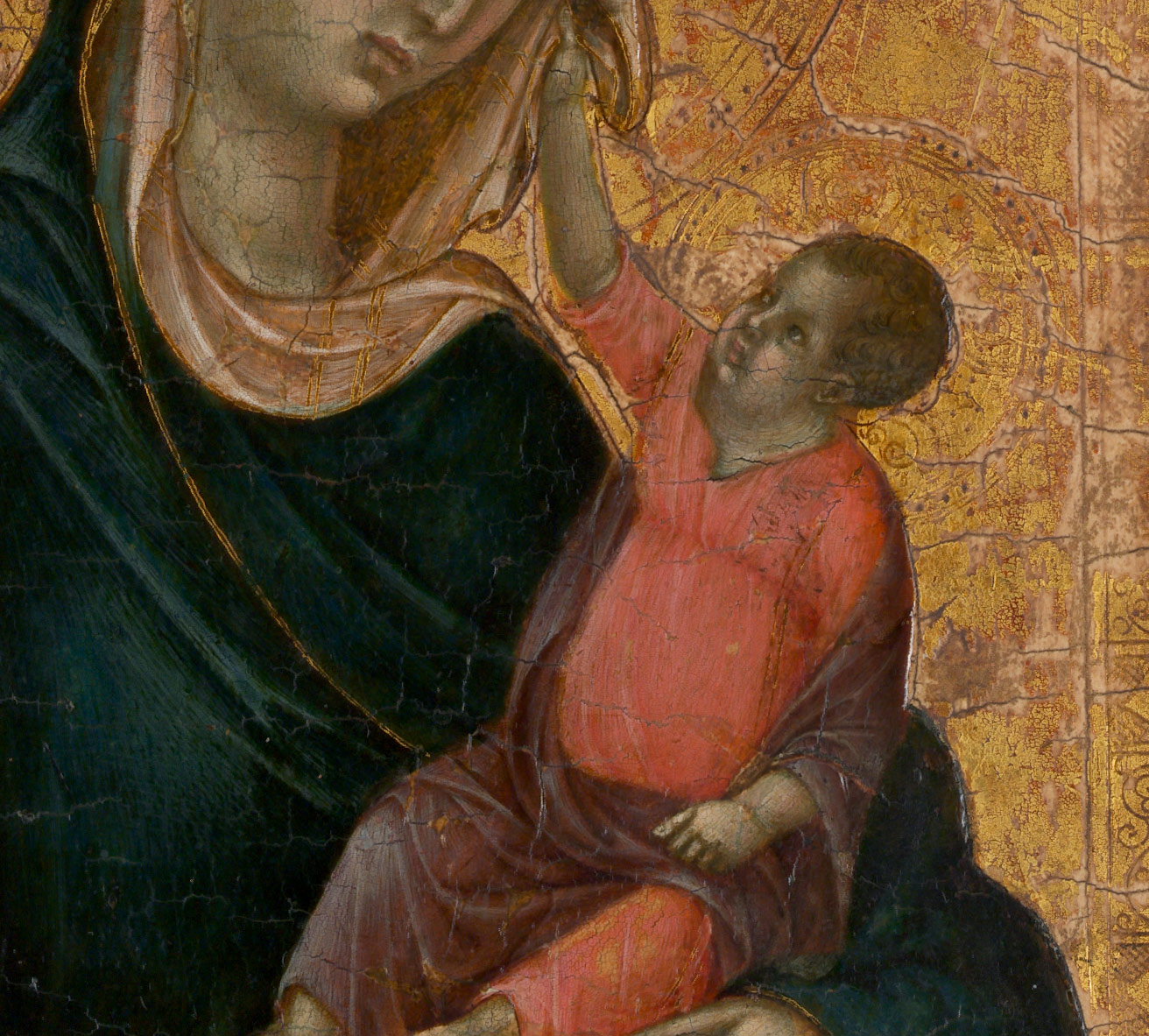
Madonna and Child, ca. 1300
Duccio di Buoninsegna (Italian, Sienese, active ca. 1278–1318)
Tempera and gold on wood; Overall, with engaged frame, 11 x 8 1/4 in. (27.9 x 21 cm); painted surface 9 3/8 x 6 1/2 in.
(23.8 x 16.5 cm)
Perhaps painted about 1300, this exquisite Madonna and Child inaugurates the grand tradition in Italian art of envisioning these sacred figures in terms appropriated from real life. The parapet—among the earliest of its kind—connects the fictive world of the painting with that of the viewer. As with his younger Florentine contemporary, Giotto, Duccio redefined the way in which we relate to the picture: not as an ideogram or abstract idea, but as an analogue to human experience.
Duccio was the founder of Sienese painting, and his influence extended as far north as Paris. There is no record of the Madonna and Child prior to its acquisition by Count Gregori Stroganoff in the late nineteenth century. The damaged areas along the bottom of the original frame are from lighted candles set in front of the painting.
也許畫約1300,這個精緻的麥當娜和兒童推出盛大的傳統,在意大利的藝術構想,這些神聖的數字,在計算核撥,從現實生活中。護欄-其中最早的,其善良的連接虛擬世界的繪畫與的觀眾。同他的年輕的佛羅倫薩當代, giotto,杜喬重新確定以何種方式,我們涉及到的情況:不是作為一個竄或抽象的理念,但作為一個模擬人的經驗。
杜喬是創始人sienese繪畫,和他的影響力擴大,北至巴黎。沒有紀錄的瑪丹娜和兒童之前,其收購計數格雷戈里stroganoff在十九世紀末期。被破壞的地區,沿底部的原有框架,是從被點燃的蠟燭,定在前面的畫。
|
|
|
|
|
|
|
|
|
|
|
|

楼主 |
发表于 24-10-2007 12:26 AM
|
显示全部楼层

Italian Peninsula, 1000–1400 a.d.
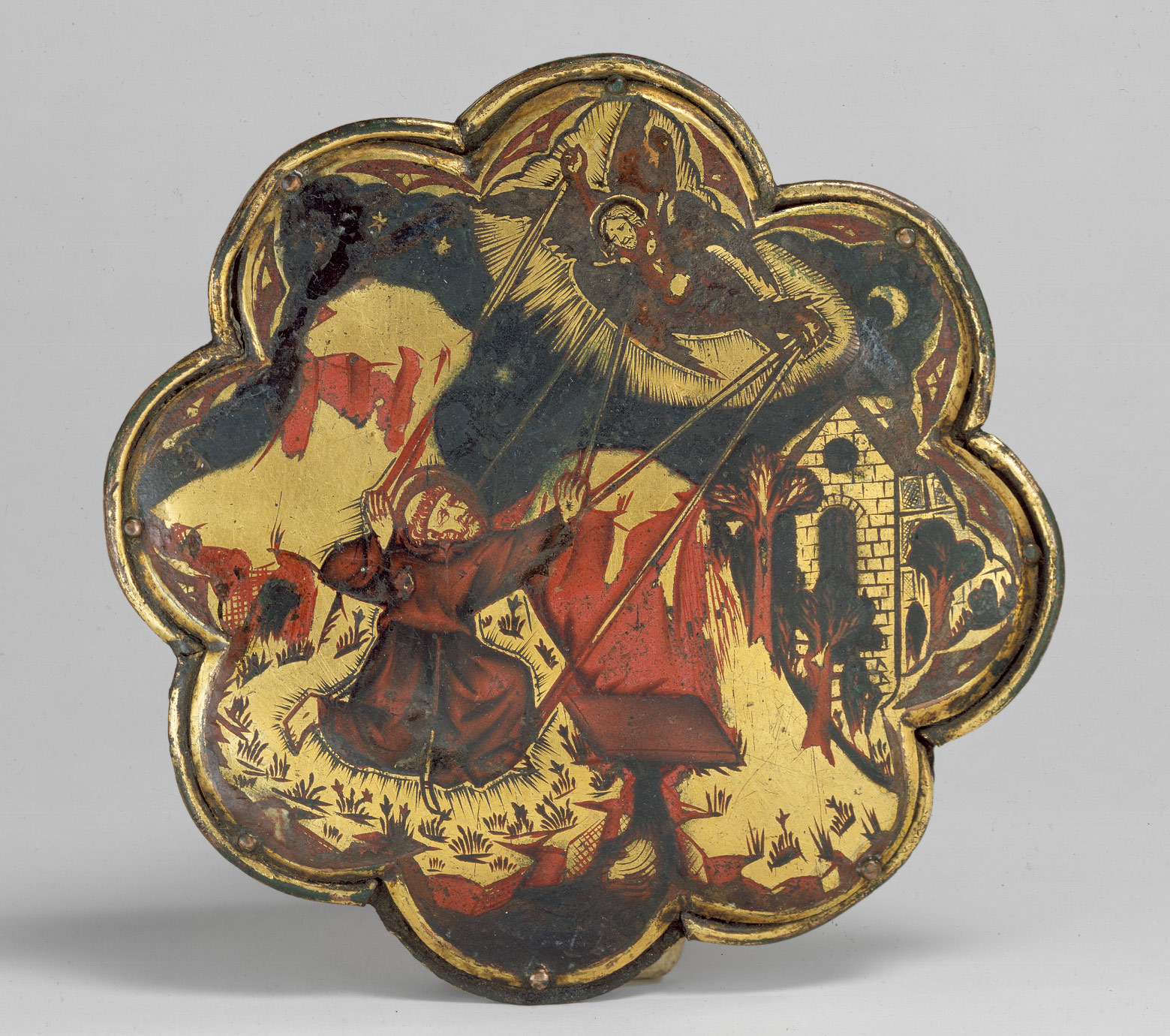
Morse, with Saint Francis of Assisi Receiving the Stigmata, 1300–1325
Italian; Made in Tuscany
Copper gilt, with champlevé enamel; Diam. 4 1/2 in. (10.8 cm)
On this enameled morse, worn at the chest to clasp a priestly garment, Saint Francis of Assisi (1181/2–1226) is shown receiving the stigmata (wounds) of Jesus Christ on his hands, feet, and side. Dressed in the brown robe with knotted cord that distinguishes his order, Francis crouches, with his weight on one knee, in a rocky landscape, across the footbridge from a small chapel. Emanating from the wounds of the Christlike seraph who appears to Francis in a vision, the stigmata became the distinctive, defining miracle of Francis' life and the emblem of his sanctity in hagiographic literature as well as in works of art. To convey the intensity of this spiritual branding, the goldsmith depicted the gilded rays that descend from the limbs of the figure searing the flesh of Saint Francis, whose body, like that of the heavenly apparition, is surrounded by an aureole of light. In this, the enamel follows the example of the Florentine painter Giotto di Bondone (1266/76–1337) and of other painters' representations of the miracle. To heighten the drama of the scene, the goldsmith invented a nocturnal landscape with a deep blue sky, pierced by stars and a crescent moon, which sets off the gold-and-crimson glow of the saint's mountain retreat.
關於這個搪瓷莫爾斯電碼,佩戴在胸部,以卡一教義製衣,聖弗朗西斯的阿西西( 1181/2-1226 ) ,是表明接受拭目以待(傷口),耶穌基督他的手,腳,及副作用。身穿棕色長袍,與扭結脊髓區別於他的命令,弗朗西斯蜷縮,他的體重就跪下來,在一處空地上的景觀,穿過行人天橋,從一個小禮拜堂。來自傷口的christlike玩的人似乎是弗朗西斯在一個遠景,惡名成了鮮明的,確定的奇蹟弗朗西斯生活及標誌,其神聖性,在英雄文學以及藝術作品。轉達強度的精神品牌,該金飾描繪鍍金射線能夠降臨,從四肢的數字烤乾了,肉中刺的聖弗朗西斯,他們的身體,這樣的天朝apparition,周圍是一個光環輕。在這方面,搪瓷如下例子佛羅倫薩畫家giotto迪邦多內( 1266/76-1337)和其他畫家交涉的奇蹟。為了提高話劇的場景中,戈德史密斯發明了一種夜間景觀與深藍色的天空,戳穿了由星星和月牙儿,其中規定了小康黃金和crimson採訪輝光的聖人的山區撤退。
|
|
|
|
|
|
|
|
|
|
|
|

楼主 |
发表于 24-10-2007 12:27 AM
|
显示全部楼层
Italian Peninsula, 1000–1400 a.d.
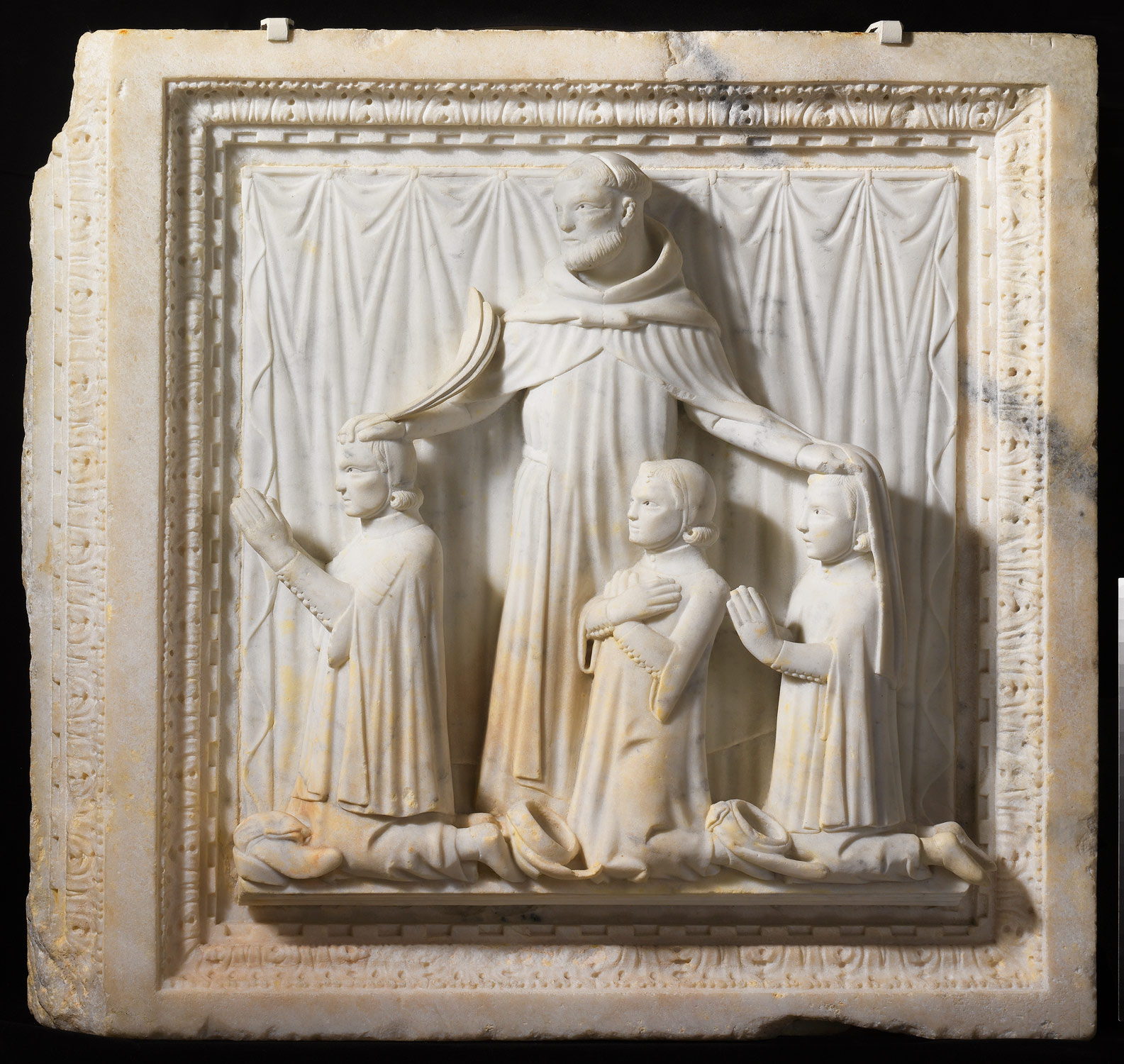
Relief with Saint Peter Martyr and Three Donors, ca. 1340
Giovanni di Balduccio (Italian, Tuscan, Bolognese, Milanese), active 1318–49
Marble; 31 1/2 x 33 7/8 in. (80 x 86 cm)
The Cloisters Collection, 2001 (2001.221)
This relief, with the standing image of the Dominican St. Peter Martyr (d. 1252) and three kneeling donors, is one of three marble panels to survive from a tomb in the Milanese church of Sant'Eustorgio. This panel was originally on the right of a central panel depicting the Enthroned Virgin and Child between two angels (Castello Sforzesco, Milan). Another relief showing St. John the Baptist and four kneeling donors, in a composition that mirrors this panel (Sant'Eustorgio, Milan), would have originally appeared on the left side.
這個救濟,與常委會的形象,多米尼加,聖彼得烈士(四第1252 ),以及三個跪在捐助者之一,是三個大理石板生存,從一個墓,在米蘭教堂sant'eustorgio。這個小組本來就有權中央委員會描繪即位處女和兒童之間的兩個天使(卡斯特羅sforzesco ,米蘭)。另一種救濟顯示,施洗者聖約翰和四個跪捐助者,在一個成分即反映這個小組( sant'eustorgio ,米蘭) ,將原本是出現在左邊。
|
|
|
|
|
|
|
|
|
|
|
|

楼主 |
发表于 24-10-2007 12:30 AM
|
显示全部楼层
Italian Peninsula, 1000–1400 a.d.
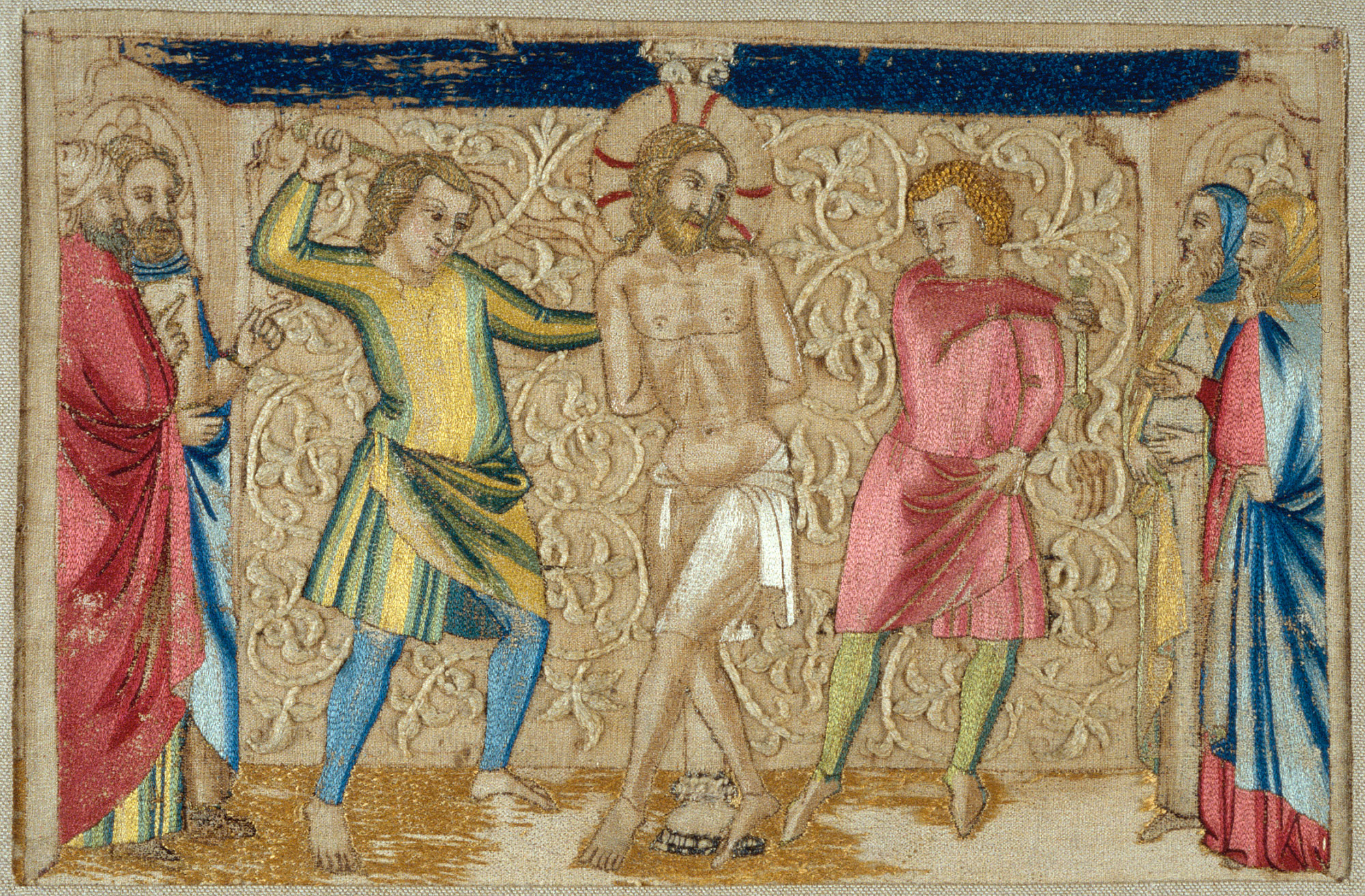
Panel from an Altar Frontal: The Flagellation, mid-14th century
Italian; Made in Florence
Silk and metallic threads on linen; 10 1/2 x 16 in. (26.7 x 40.6 cm)
Bequest of Charles F. Iklé, 1963 (64.27.18)
While the needlework on this panel has been attributed to the Florentine embroiderer Geri Lapi, the designer has not been identified. Cooperation between painters and embroiderers is evidenced in Il Libro dell'arte, a manual for artists written by the Italian painter Cennino Cennini (ca. 1370&151;ca. 1440). More than twenty shades of silk and metallic threads give richness to the design, and the gold background is enlivened with raised scrolling vines. The Flagellation is one of twelve panels attributed to Geri Lapi depicting the life of Christ, of which nine are in the Museum. The format and subject indicate that the ensemble decorated an altar frontal, perhaps the antependium described in the inventory of Jean, duc de Berry (1340–1416), brother of King Charles V of France (r. 1364–80) and one of the great art patrons of the fourteenth and fifteenth centuries.
而needlework關於這個小組一直歸功於佛羅倫薩刺繡傑瑞拉皮,設計者並沒有發現任何問題。合作畫家和繡就是明證,在白細胞介素libro知心,一本手冊,為藝術家寫的意大利畫家琴尼諾cennini (約1370 &151;鈣。 1440 )。二十多個陰涼的絲綢和非金屬線程,讓豐富的設計,和黃金的背景是搞活與提高滾動藤蔓。該自虐是其中12個展板歸功於傑瑞拉皮描繪出生命的基督,其中9個是在博物館。格式和課題表明,該樂團裝飾祭壇額葉,也許antependium描述庫存牛仔布,德德貝瑞( 1340年至1416年),兄弟的國王查爾斯第五節法國( r. 1364年至1380年)和其中的偉大的藝術贊助人的第十四和第十五世紀。 |
|
|
|
|
|
|
|
|
|
|
|

楼主 |
发表于 26-10-2007 11:42 PM
|
显示全部楼层
African Christianity in Ethiopia
在埃塞俄比亚(非洲东部国家)的基督教
The adoption of Christianity in Ethiopia dates to the fourth-century reign of the Aksumite emperor Ezana. Aksum'sgeographic location, at the southernmost edge of the Hellenized NearEast, was critical to its conversion and development. The kingdom waslocated along major international trade routes through the Red Seabetween India and the Roman empire.The story of Ezana's conversion has been reconstructed from severalexisting documents, the ecclesiastical histories of Rufinus andSocrates Scholasticus. Both recount how Frumentius, a youth from Tyre,was shipwrecked and sent to the court of Aksum. Frumentius sought outChristian Roman merchants, was converted, and later became the firstbishop of Aksum. At the very least, this story suggests thatChristianity was brought to Aksum via merchants. Ezana's decision toadopt Christianity was most likely influenced by his desire to solidifyhis trading relationship with the Roman empire. Christianity affordedthe possibility of unifying the many diverse ethnic and linguisticpeoples of the Aksumite kingdom, a goal of Ezana's leadership. Aksumwas one of the earliest states to develop a coin system in order toservice its sophisticated and prosperous economy. Emperor Ezana was thefirst world leader to put the cross on coins that are the earliestexamples of Christian material culture from Ethiopia.
Remains of distinctive Aksumite church architecture have been locatedin Aksum, Matara, and Adulis. These are oriented basilicas with steppedpodia, which are accessed by a monumental set of stairs. These churchesinclude an apse with lateral square chambers, introduced into thedesign of basilicas along the south coast of Asia Minor, Syria, andPalestine by the fifth century. The construction of churches isbelieved to have served the religious needs of the new administrativeand military officials settling in expanded territories. The growth ofthe Aksumite state ended after the Persian conquest of South Arabia,which displaced the trade routes of the Red Sea.
While its origins are unclear, the Zagwe dynasty arose sometime duringthis period of reduced wealth and international prestige and probablylasted until 1270. The almost complete lack of surviving manuscriptsmakes it difficult to obtain a clear picture of the period. After theabandonment of Aksum, the previous political and economic capital, thecity of Roha, now called Lalibela, was established as the ceremonialcenter of the Zagwe dynasty. Churches most likely based on Aksumiteprecedents were hewn out of living rock in the mountains of Lasta. TheChurch of the Redeemer, the largest and perhaps most famous church atLalibela, may be an architectural copy of the Cathedral of Mary of Zionat Aksum. The interiors of these magnificent structures were coveredwith paintings and murals.
Yekunno Amlak's overthrow of the reigning Zagwe dynasty in 1270 marksthe beginning of the Early Solomonic period (1270–1530). Amlak basedhis claim to legitimacy on an alleged lineage with the ancient rulersof Aksum originating with King Solomon and the Queen of Sheba. Thisperiod was one of dramatic social and cultural change and development.Extensive international trade returned to Ethiopia since Europeans were seeking alternatives to trading along Islamic-controlled routes.This resurgence lasted until the Portuguese rounded the Cape of GoodHope. Evoking the legend of King Solomon, rulers of this periodestablished royal churches lavishly decorated with wall paintings, goldornamentation, and precious fabrics. These included the famousrock-hewn churches of Tegre and Lasta. Through affiliations withmonastic leaders, these secular rulers used artistic patronage,including the recruitment of European artisans, to establish theirauthority and enhance their prestige. This interface with Europeexposed Ethiopian artists to new mediums, technologies, and aestheticsensibilities. These influences are reflected in wall paintings througha shift from rigid frontality and the widespread use of geometricpatterning to a three-quarter pose, a greater fluidity of line, and theuse of modeling to describe three-dimensional volumetric figures. Thisnew style contained elements of both Byzantine and Italian prototypes.
Monasteries, for example the Dabra Hayq Estifanos monastery in Amhara,were established as centers of learning. These complexes oftencontained extensive scriptoria for extraordinary illuminated manuscripts,of which very few survive. The labor-intensive work of the scriptoriumwas often considered a crucial dimension in a monk's spiritualtraining. There were many monasteries in the region of Lake Tana,including that of Fré Seyon, one of two known artists of this period.Seyon is credited with the development of the devotional Marian Iconimages and style. Mary became an extremely important figure in theEthiopian church when Emperor Zar'a Ya'eqob (r. 1434–68) mandated thereading of the Miracles of the Virgin Mary and that she be honored atmost of the thirty feast days in the liturgical year. Zar'a Ya'eqob wasparticularly successful at utilizing the power of her visual imagery topublicly emphasize teachings about her centrality to Christiansalvation.
The Islamic jihads of 1531 through 1543 by the neighboring state ofAdal destroyed many royal churches, libraries, and monasteries,resulting in the loss of all of their records. Rare examples of theextraordinary royal patronage of the Early Solomonic period thatsurvived were preserved in extremely remote, inaccessible monasteries.A long period of chaos followed the Adalite invasion, includingsubsequent incursions by enterprising groups seeking to fill the powervoid left by the fall of the Aksumites. In the seventeenth century, thesignificantly reduced Christian empire established the new capital ofGondar. Until its assault by Tigray in 1769, Gondar was the spiritual,artistic, and political center of the empire and therefore was a sitefor the principle scriptoria and painters' workshops, as well asarchitectural innovations.
While earlier Aksumite churches were circular, later constructionsdeliberately attempted to mimic those of the description of KingSolomon's temple in the Old Testament. The churches built in Gondarhave a square sanctuary with two aisles running along the periphery.The interiors are entirely covered in both murals and paintings thatwere commissioned by the wealthy elite in order to assist in theirascension to heaven. This was a period of intense artistic production,including, in particular, considerable quantities of icons devoted to the Virgin Mary.
The Ethiopian royal dynasty remained intact until the overthrow in 1974of Haile Selassie, the last Christian emperor, by a military coup.
|
|
|
|
|
|
|
|
|
|
| |
 本周最热论坛帖子 本周最热论坛帖子
|